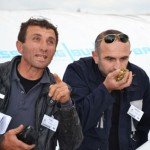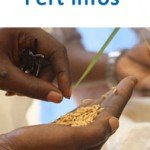On the occasion of his visit to France in 2014, Fert met Haingoarison Randrianomanjanahary, President of the stakeholders in the land of Solidarity (SIF) in Madagascar. Haingo is also director of Fifata, Fert partner for 25 years.
1. Can you quickly introduce SIF?
The SIF is a Malagasy national platform established in 2003 working in the field of land. It is an organization of civil society that aims to protect the rights of Malagasy farmers by challenging the authorities on anomalies detected in Malagasy campaigns.
It now has 27 members including different types of farmers’ organizations as Fifata, the network Soa, NGOs or private companies working in the field of land.
It also aims to make proposals for land laws. In 2005, several land laws should have been implemented but few were eventually to implementing decree.
2. What are the means of action of the SIF and its mode of operation?
In terms of governance, the SIF has an Executive Committee (Comex), the equivalent of a board of directors, and an office consisting of 7 members who meet every two months, despite the travel difficulties elected localized in different regions. As a representative of Vombo – peasant organization in the region Bongolava – I was elected President in 2010 for two years and re-elected in 2012 for a second and final term.
FIS also has a technical team including a coordinator for legal training, two lawyers who receive the complaints of farmers, an economist who analyzes the field surveys, a communications officer, an agronomist who puts consistent activities on land and food security issues, and a computer.
In addition to the contributions of its members, FIS also has partners like the CCFD – Terre Solidaire (depuis 2009) or the international platform ILC (International Land Coordination), and until there is little, Saha program.
3. To illustrate, what file types you process?
For example, a previous Deputy Prime Minister had decided to close the land offices (created at the 2005 land reform, which decentralized land service). The SIF has reacted strongly to the announcement of the news.
We may also mention some particularly emblematic situations of our work on the land in Madagascar:
- In the district of Soalala – Boeny region, we knew through the media that a Chinese company will locate in the region to exploit iron ore deposits. We were there to check the profile information, and meet with local authorities. In particular, we met with the district manager but also the mayors of the towns that were not even informed of the implementation project. We have therefore undertaken to faires fragmented states to form a lobbying record, ignoring the state that people living in these places and operate land;
- Bionexx, a French company producing Artemisia (medicinal plant) operates a land of about 650 ha in the municipality of Faharetana, Itasy region. The people of the area have approached the FIS to support them in their efforts and that the SIF is a mediator in order to retain their right of access to land on which some families have lived for generations;
- In the same region Itasy, a French settler had a titled land. Since his departure, no updates had been made and peasants today exploit these lands. We visited the place to make piecemeal boundaries and talk with farmers to supply the authorities present data on the occupation of the land but especially to acknowledge the existence of farmers on the spot;
- In the Anosy region the SIF performs mediation between the local population and the company that operates the QMM ilmenite [titanium ore and iron]. The company is trying to negotiate with the local population, but sticks to the surface value of the land (eg counting plants). The SIF does not stick to the value of the land now but their value in absolute terms, over the long term. MEQ company itself picked the SIF actors for their expertise in terms of mediation.
The objective of these activities is able to offer to the national authorities who run the country land laws that will protect elements Malagasy particularly Malagasy farmers whose land is the essential factor of production.
4. How is the SIF challenged by farmers in the communities?
The SIF is now recognized and solicited by mail or phone, in the office of the SIF in Antananarivo or directly from the representatives of 27 members.
From 2003 to 2010, the shares of the SIF focused around awareness. In Bongolava example, a region known for its large migratory movements, the SIF organized with Vombo, an event on “Land and migration”.
After 2010, the SIF made a strategic work that has changed the structure to a civil society platform dedicated to issues on the land, giving it greater visibility at national level on this issue. It is now heard and listened to the national level. SIF has contributed to the National Programme on Land (NPL) Act 1 and is now integrated in the working group on the NPL Act 2. The proof in the last presidential elections in late 2013, the SIF had established a charter on land to candidates. Only two have signed but all candidates have repeated this in whole or in part Charter in their platform. Thus, among the first decisions taken by the new President of the Republic elected in late 2013, the land appears as a priority; President has suspended indefinitely the sale of land owned by the Malagasy State.


